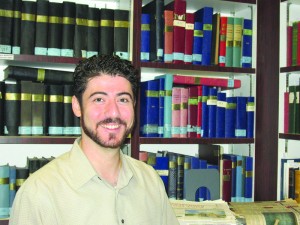
Photo: Barlow Der Mugrdechian
Diana Gasparyan
Staff Writer
The Armenian Studies Program offers a variety of courses, but Masterpieces of Armenian Culture (Armenian 148) is unique because it is the only course that fulfills an upper division Interdisciplinary General Education requirement in the area of Arts and Humanities. One result is that more non-Armenian juniors and seniors can learn about Armenian culture.
Students in the Armenian 148 class study various examples of the classic works of writers such as Grigor Narekatsi, Hovhannes Toumanian, Siamanto, Daniel Varoujan, and many more in English translation. They are also able to explore the Armenian stories of Hayk and Bel, Ara the Fair and Shamiram, the Legend of Aram, and the Armenian National Epic David of Sassoun.
“The course is a way for students to discuss how Armenian culture and identity are represented through literature,” said Professor Hagop Ohanessian, who has been teaching this course for three years.
Non-Armenians who take the course learn about the ancient Armenian culture and about Armenian history.
One of the main lessons of the course is to see how the writers themselves explore their identity and how this leads to the maintenance of Armenian culture. This is accomplished by reading excerpts in English from various writers and discussing how those works connect to culture and identity.
“There is a lot to learn in this class. Learning about another culture always has an impact,” said senior Nabil Saeed.
Junior Anthony Avedisian stated how interesting it is that the Armenians have such a long history and he appreciates being given the opportunity to learn about it.
“It helps me connect to my history,” said Avedisian. Many students in the course relate to these feelings, because the course helps build a sense of pride.
Other students were interested in expanding their knowledge of the Armenians. “It is fascinating to learn about how ancient Armenian history is and about how rich the literature is, but I was most interested in learning more about the Genocide,” said junior Erika Kogan. The Armenian Genocide is a popular topic, which draws students into the class.
After taking the course many students found it remarkable how Armenians have defended their faith and their land, and have stood up for their families.
Education is a key aspect in informing the Armenian youth about their historical roots and about Armenian identity so that the culture can continue to be passed down to future generations.
The Armenian 148 course has many positive aspects and offers many opportunities for students to learn about Armenian culture.
 Hye Sharzhoom Armenian Action
Hye Sharzhoom Armenian Action